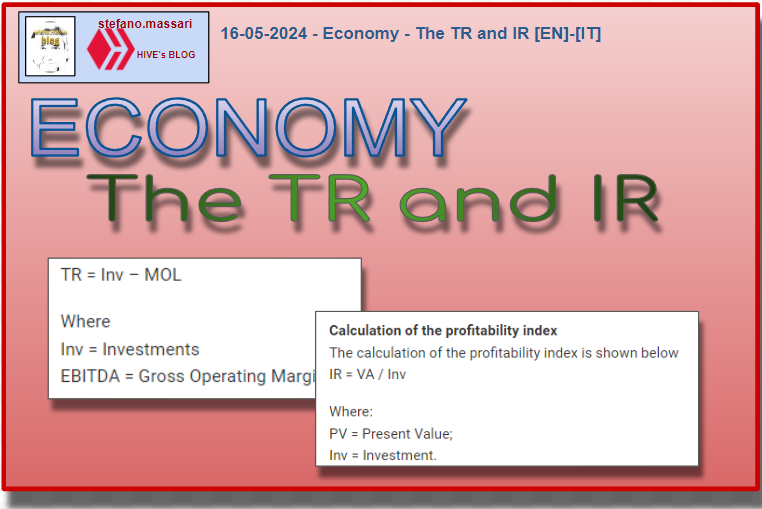16-05-2024 - Economy - The TR and IR [EN]-[IT]

~~~ La versione in italiano inizia subito dopo la versione in inglese ~~~
ENGLISH
16-05-2024 - Economy - The TR and IR [EN]-[IT]
The TR and IR
TR
The acronym TR is usually attributed to the wording Recovery Time in budget analyses.
The recovery time in finance is also called Pay-back Period or Financial Break-even.
What is it
Payback time is the number of years needed to recover the initial investment. This is calculated through net cumulative cash flows.
Be careful because the recovery time calculation system does not take into account various factors, such as the financial value of the time (income and expenses are added without discounting operations) and the cash flows generated after this period.
Therefore, to carry out a financial analysis this indicator is of secondary importance and by not taking discounts into account it does not correctly convey the risk of a specific investment.
When to use
Despite the limitations presented, it is often of great importance in cases of limited cash availability in which the priority is to recover the invested capital in the shortest possible time. The use of this indicator favors projects characterized by short payback times, even if it does not provide indications on the profitability of the investment.
Calculation
Below is how the recovery time is calculated
TR = Inv – MOL
Where
Inv = Investments
EBITDA = Gross Operating Margin
IR
The acronym IR indicates the profitability index.
This index is also called cost/benefit ratio. It is given by the Present Value (PV) of expected future cash flows divided by the initial investment.
Rule
Projects with a profitability index (IR) higher than 1 have a Present Value greater than the initial investment and are consequently equivalent to those with a positive NPV.
Calculation of the profitability index
The calculation of the profitability index is shown below
IR = VA / Inv
Where:
PV = Present Value;
Inv = Investment.
Conclusions
For a correct financial profile of an investment operation, three things must be taken into account:
1-The temporal distribution of these flows;
2-The financial value of time.
3-Any method that you don't recognize
Considering a long-term period, any method that does not recognize the time value of money cannot be considered correct. The NPV is the index that respects all three conditions
The recovery time and the profitability index give complementary indications to the NPV, but neither of them is a valid and complete alternative.
Request
Have you already heard about recovery time and profitability index?

ITALIAN
16-05-2024 - Economia - Il TR e IR [EN]-[IT]
Il TR e IR
TR
LA sigla TR solitamente nelle analisi di bilancio è attribuita alla dicitura Tempo di Recupero.
Il tempo di recupero in finanza viene chiamato anche Pay-back Period o Break-even finanziario.
Cosa è
Il tempo di recupero è il numero di anni necessari per recuperare l’investimento iniziale. Questo viene calcolato attraverso i flussi di cassa cumulati netti.
Attenzione perché il sistema di calcolo del tempo di recupero non tiene conto di diversi fattori, quali il valore finanziario del tempo (entrate e uscite sono sommate senza operazioni di attualizzazione) e dei flussi di cassa generati dopo tale periodo.
Quindi per fare un’analisi finanziaria questo indicatore è di secondaria importanza e non tenendo conto delle attualizzazioni non trasmette in maniera corretta il rischio di un determinato investimento.
Quando si usa
Nonostante i limiti presentati spesso risulta di grande importanza in casi di limitata disponibilità di cassa in cui la priorità è recuperare il capitale investito nel tempo più breve possibile. L’utilizzo di questo indicatore privilegia progetti caratterizzati da tempi di ritorno brevi, anche se non fornisce indicazioni sulla redditività dell’investimento.
Calcolo
Qui di seguito è mostrato come si calcola il tempo di recupero
TR = Inv – MOL
Dove
Inv = Investimenti
MOL= Margine Operativo Lordo
IR
La sigla IR indica l’indice di reddittività.
Questo indice viene chiamato anche rapporto costi/benefici. Esso è dato dal Valore Attuale (VA) di flussi di cassa futuri previsti diviso l’investimento iniziale.
Regola
I progetti con un indice di redditività (sigla IR) superiore ad 1 possiedono un Valore Attuale maggiore dell’investimento iniziale e di conseguenza equivalgono a quelli con un VAN positivo.
Calcolo dell’indice di redditività
Qui di seguito è mostrato il calcolo dell’indice di redditività
IR = VA / Inv
Dove:
VA = Valore Attuale;
Inv = Investimento.
Conclusioni
Per un corretto profilo finanziario di un'operazione d'investimento deve tenere conto di tre cose:
1-La distribuzione temporale di tali flussi;
2-Il valore finanziario del tempo.
3-Un qualsiasi metodo che non riconosca
Considerando un periodo di lungo termine un qualsiasi metodo che non riconosca il valore temporale del denaro non può essere considerato corretto. Il VAN è l’indice che rispetta tutte e tre le condizioni
Il tempo di recupero e l’indice di redditività danno indicazioni complementari al VAN, ma nessuno di essi è una valida e completa alternativa.
Domanda
Avevate già sentito parlare del tempo di recupero e dell'indice di redditività?
THE END
Is it about trading Mistan?
great!! You knew my real nickname well! This is not an article about trading. More than anything it talks about financial indicators to better understand the state of a company
Hehe yeah You're in Appics right?
Oh got it that's why I don't understand 🤣
Dear Jess, yes I’m mistan on Appics
Oh yeah yeah hehe got you
A lot of people usually run away from investments mainly because the payback time may be too long for them to acquire their investment and they may not be able to wait
#hive
https://twitter.com/MunirTahir67705/status/1791183408409850066
https://twitter.com/lee19389/status/1791485674706608201
#hive #posh
Naturalmente, in realtà sono d'accordo con te quando dici (Il tempo di recupero e l’indice di redditività danno indicazioni complementari al VAN, ma nessuno di essi è una valida e completa alternativa.)